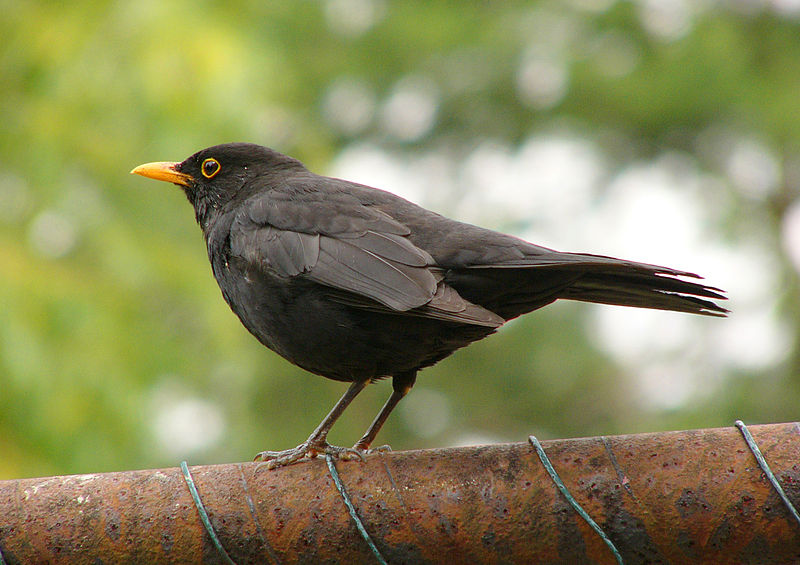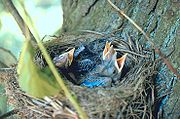The Blackbird, Common Blackbird or Eurasian Blackbird (Turdus merula) is a species of true thrush which breeds in Europe, Asia, and North Africa, and has been introduced to Australia and New Zealand. It has a number of subspecies across its large range; a few of the Asian subspecies are sometimes considered as full species. Depending on latitude, the Blackbird may be resident, partially migratory or fully migratory.[2]
The male of the nominate subspecies, which is found throughout most of Europe, is all black except for a yellow eye-ring and bill and has a wide range of vocalisations; the adult female and juvenile have mainly brown plumage. This species breeds in woods and gardens, building a neat, mud-lined, cup-shaped nest. It is omnivorous, eating a wide range of insects, earthworms, seeds, berries, and fruits.
Both sexes are territorial on the breeding grounds, with distinctive threat displays, but are more gregarious during migration and in wintering areas. Pairs will stay in their territory throughout the year where the climate is sufficiently temperate. This common species has given rise to a number of literary and cultural references, frequently related to its melodious song.
Taxonomy
The Blackbird was described by Linnaeus in his Systema Naturae in 1758 as Turdus merula (characterised as T. ater, rostro palpebrisque fulvis).[3] The binomial name derives from two Latin words, Turdus, "thrush", and merula, "blackbird", the latter giving rise to the French name for this species, merle.[4] There are about 65 species of medium to large thrushes in the genus Turdus, characterised by rounded heads, longish pointed wings, and usually melodious songs. The Blackbird seems to be closest in evolutionary terms to the Island Thrush (T. poliocephalus) of the southwest Pacific, which probably diverged from merula stock fairly recently.[5]
It is not immediately clear in modern English why the name "Blackbird", first recorded in 1486, was applied to this species, but not to another common black European bird, such as the Carrion Crow, Raven, Rook or Jackdaw. However, in Old English, and in modern English up to about the 18th Century, "bird" was used only for smaller or young birds, and larger ones, such as crows were called "fowl". The Blackbird was therefore the only widespread and conspicuous "black bird" in the British Isles.[6] Until about the 17th century, another usual name for the species was ouzel, ousel or wosel (from Old English osle). Another variant occurs in Act 3 of Shakespeare's A Midsummer Night's Dream, where Bottom refers to The Woosell cocke, so blacke of hew, With Orenge-tawny bill. The ousel usage survived later in poetry, and still occurs as the name of the closely related Ring Ouzel, and in Water Ouzel, an alternative name for the unrelated but superficially similar White-throated Dipper (Cinclus cinclus).[7]
Two related Asian Turdus thrushes, the White-collared Blackbird (T. albocinctus) and the Grey-winged Blackbird (T. boulboul), are also named as blackbirds,[5] and the Somali Thrush (T. (olivaceus) ludoviciaeis) is alternatively known as the Somali Blackbird.[8]
Around 20 species of the New World icterid family are named as blackbirds because of their superficial resemblance to the Old World thrushes, but they are not closely related, being nearer to the New World warblers and tanagers in evolutionary terms.[9] They include the Red-winged Blackbird (Agelaius phoeniceus), Red-breasted Blackbird (Sturnella militaris), Yellow-headed Blackbird (Xanthocephalus xanthocephalus) and the Melodious Blackbird (Dives dives).[9]
Breeding
The male Blackbird attracts the female with a courtship display which consists of oblique runs combined with head-bowing movements, an open beak, and a "strangled" low song. The female remains motionless until she raises her head and tail to permit copulation.[20] This species is monogamous, and the established pair will usually stay together as long as they both survive.[11] Pair separation rates of up to 20% have been noted following poor breeding.[30] Although socially monogamous, there have been studies showing as much as 17% extra pair paternity.[31]
Nominate T. merula may commence breeding in March, but eastern and Indian races are a month or more later, and the introduced New Zealand birds start nesting in August.[5][21] The breeding pair prospect for a suitable nest site in a creeper or bush, favouring evergreen or thorny species such as ivy, holly, hawthorn, honeysuckle or pyracantha,[32] and the female builds a neat cup-shaped nest from grasses and similar vegetation, which she then lines with mud or muddy leaves. She lays three to five (usually four) bluish-green eggs marked with reddish-brown blotches,[20] heaviest at the larger end;[21] the eggs of nominate T. merula are 2.9 x 2.1 centimetres (1.14 x 0.93 in) in size and weigh 7.2 grammes (0.25 oz), of which 6% is shell.[33] Eggs of birds of the southern Indian races are paler than those from the northern subcontinent and Europe.[5]
The female incubates for 12–14 days before the altricial chicks are hatched naked and blind. Fledging takes another 10–19 (average 13.6) days, with both parents feeding the young and removing faecal sacs.[11] The young are fed by the parents for up to three weeks after leaving the nest, and will follow the adults begging for food. If the female starts another nest, the male alone will feed the fledged young.[20] Second broods are common, with the female reusing the same nest if the brood was successful, and three broods may be raised in the south of the Blackbird's range.[5]
Montane subspecies, such as T. maximus have a shorter breeding season, smaller clutches (2–4 eggs, averaging 2.86), but larger eggs than merula. They produce just one brood per year, and have a slightly shorter incubation period of 12–13 days, but a longer nestling period (16–18 days).[34]
A Blackbird has an average life expectancy of 2.4 years,[35] and, based on data from bird ringing, the oldest recorded age is 21 years and 10 months.[36]
Songs and calls
The first-year male Blackbird of the nominate race may start singing as early as late January in fine weather in order to establish a territory, followed in late March by the adult male. The male's song is a varied and melodious low-pitched fluted warble, given from trees, rooftops or other elevated perches mainly in the period from March to June, sometimes into the beginning of July. It has a number of other calls, including an aggressive seee, a pook-pook-pook alarm for terrestrial predators like cats, and various chink and chook, chook vocalisations. The territorial male invariably gives chink-chink calls in the evening in an (usually unsuccessful) attempt to deter other Blackbirds from roosting in its territory overnight.[20] Like other passerine birds, it has a thin high seee alarm call for threats from birds of prey since the sound is rapidly attenuated in vegetation, making the source difficult to locate.[37]
At least two subspecies, T. m. merula and T. m. nigropileus, will mimic other species of birds, cats, humans or alarms, but this is usually quiet and hard to detect. The large mountain races, especially T. m. maximus, have comparatively poor songs, with a limited repertoire compared with the western, peninsular Indian and Sri Lankan taxa.[5]
Feeding
The Blackbird is omnivorous, eating a wide range of insects, earthworms, seeds and berries. It feeds mainly on the ground, running and hopping with a start-stop-start progress. It pulls earthworms from the soil, usually finding them by sight, but sometimes by hearing, and roots through leaf litter for other invertebrates. Small vertebrates such as frogs, tadpoles and lizards are occasionally hunted. This species will also perch in bushes to take berries and collect caterpillars and other active insects.[20] Animal prey predominates, and is particularly important during the breeding season, with windfall apples and berries taken more in the autumn and winter. The nature of the fruit taken depends on what is locally available, and frequently includes exotics in gardens. In northern India, banyan and mulberry fruits are frequently eaten, with Erythrina and Trema species featuring further south.[5]
source: en.wikipedia.org





Tidak ada komentar:
Posting Komentar